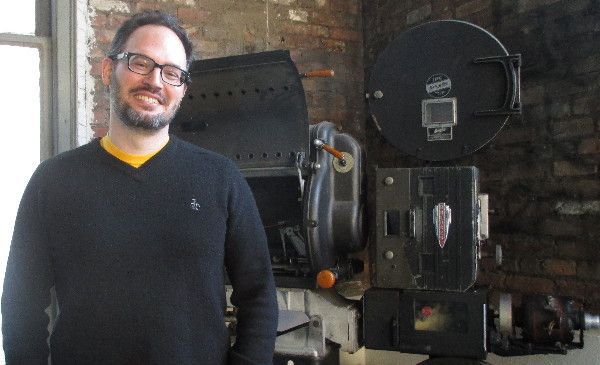 |
| J.R. Hughto on Diamond On Vinyl: "You are looking to capture naturalism in the performance." Photo: Anne-Katrin Titze |
In my conversation with Sonja Kinski, a family tree was rooted in the cinematic threads revealed by her. Speaking with the director J.R. Hughto, the mining of his Diamond On Vinyl starts out with the nature of sound, the influences of the Dardenne Brothers, Thomas Vinterberg, Walter Murch, and the way Katharine Hepburn responds naturally in George Cukor's The Philadelphia Story. We talked about the need for more of a discussion on gender and the part Abdellatif Kechiche's Blue Is the Warmest Colour can play for this awareness.
Anne-Katrin Titze: Your protagonist In Diamond On Vinyl collects records called Safe and Sound, originally meant to be played when you're not at home to give burglars the impression someone is there. Are the records real? Do they exist?
J.R. Hughto: There are real versions of them. When I started the script, I knew that [I wanted] the sound aspect. Originally it was radio plays but I wasn't entirely satisfied with it because it was for an audience. Friends of mine turned me on to those records, and I knew here's the catalyst. So those records did exist. A man and a woman, you put the record on, you leave and a burglar would think that somebody is home, theoretically. They existed only for a brief moment in time. So here is the framing device for the obsession - that he is obsessed with something that no one else would even bother listen to. Of course, the nature of the banal relationship on the record. There are moments that are kind of transcendent and beautiful and there are other moments that are 'Do you want coffee?' 'Yeah, black.' and then it keeps going on about coffee.
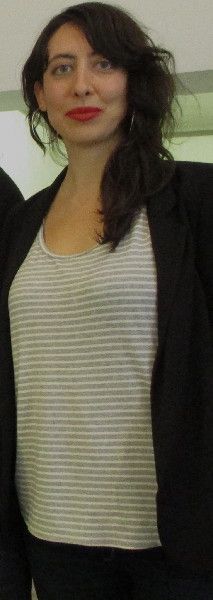 |
| Nina Millin at the New York premiere of Diamond on Vinyl Photo: Anne-Katrin Titze |
AKT: This is what he, Henry (Brian McGuire), is looking for - the perfect conversation. The perfectly natural conversation. That, I believe, is not an obsession that is so rare. It's something many people can relate to. I know myself from interviews I am recording with filmmakers the moments when I know this was good, a real conversation and natural. That desire is central in your film.
JRH: Yes, of course. I think it is there for everyone. There is this tension. You have an interaction that has some sort of pressure, a job interview, a first date, something like that. You naturally work through it in your head, right? We think of this as normal. Now let's think of someone who has social anxiety but also wants this naturalistic perfected relationship but is afraid of exposing himself. He is reworking the conversations to find out what is natural about them so he can have a pat answer that sounds real, that sounds in the moment.
AKT: As a director you want that as well?
JRH: As a filmmaker, of course, you want to have a performance that you know is scripted. You are seeing a movie that has a plot that goes from A to B to C. Even in a film that has a lot of improv elements it still is tightly scripted and yet, you are looking to capture naturalism in the performance.
AKT: CK Dexter Haven, no, George Kittredge, in George Cukor's The Philadelphia Story (1940) says to Katharine Hepburn's Tracy Lord: "I want you to behave naturally!" And she repeats it to him with a pause, an added comma; "I want you to behave, naturally." That is what he really means - control. Tell me about your actors. Beth (Nina Millin) is very good angry. When I talked to Sonja earlier she seemed surprised how menacing she as Charlie is in her first scene. How do you see this encounter of the two women?
JRH: I agree there is a threat. The threat to me plays out in the moment of the revelation that Beth confides. Not only did she hear that maybe he doesn't love her but that he's been recording their sex life. Her response to that is when the hook is set for Charlie. Not only this particular moment with this woman who is so distraught but finding out the other side of the equation. Who is this man who does these things? In my work, what I'm trying to do is have great density. Everything can be seen multiple ways. She can be the Femme Fatale and also be the naive woman who is hurt or a threat. Same thing for Henry.
AKT: By naming her Charlie you point us to gender issues. How important is that thread in your film?
JRH: A hundred percent.
AKT: Are you going in a specific theoretical direction, or not?
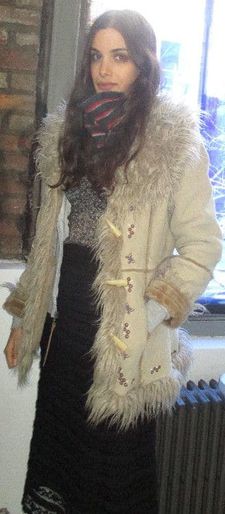 |
| Sonja Kinski: "She can be the Femme Fatale and also be the naive woman..." Photo: Anne-Katrin Titze |
JRH: In the script it was actually stronger. There is also this very nebulous relationship between Kate (Jessica Golden) and Charlie. One of the questions for the audience in the background should be, are they a couple, at what point in the film have they become a couple, have they always been a couple from the beginning? Also with Beth, there was more of an echo in the script.
AKT: You can still pick up on it in the finished film.
JRH: Yes, we just pushed it back a little. It's delicate. For me, I feel I have to tread lightly because I am this gender - straight man. That means that I feel that I have to do a tremendous amount of research and interviews to make myself feel comfortable addressing these kinds of things. Not because I don't have empathy or knowledge but because it can be such a hot button.
AKT: Yes it can. You are alluding to Kechiche's latest film Blue is the Warmest Colour, correct?
JRH: Right. I want to see it. I haven't seen it, yet. We have to bring this up. There has to be a discussion about it. Unfortunately, in filmmaking we have a history of it being dominated by a gender and a race and a type in this country particularly. For better or worse, even though I'm in the minority as an independent filmmaker with very limited means and no connections, in every other way, I'm a privileged majority. I have to be cogniscant of that position of privilege and respect it.
AKT: You use the limitations you speak of well. We don't need big changes in location and elaborate sets because that is not the story you want to tell. Voyeurism in your film is through sound. What came first the voyeurism or the sound?
JRH: It's the chicken and the egg. Both at once. I would lean towards sound only because I'm completely obsessed with [sound editor] Walter Murch and his work, with films like [Francis Ford Coppola's 1974] The Conversation. I'm a very pragmatic filmmaker, I want to identify what I have access to. When you have no money, you have performance and you have sound, right?
AKT: You worked with a sound designer?
JRH: Ugo Derouard, who is amazing. We will definitely continue to work together. Everything in the shoot was set up to get the maximum performance. The nature of the film means it has to be tightly scripted because it has to repeat and it has a shape, you know, this kind of spiral.
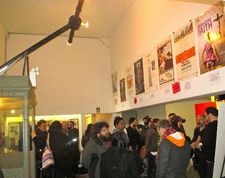 |
| Diamond On Vinyl at the Maya Deren Anthology Film Archives Photo: Anne-Katrin Titze |
AKT: You've been at a few festivals this year - was there a film that stood out to you?
JRH: I particularly loved [Destin Cretton's] Short Term 12 which was really wonderful. For a film that could become maudlin, that could go into all these directions that could make it very leaden - to stay light even when it's dark at times. I thought it was beautiful.
AKT: The central images for me when I think of the film are the running scenes from the building and the capture. Do you have a scene that embodies the film for you?
JRH: Yeah. When the two of them are in the safety room sitting next to each other. That's the scene for me that stuck in my head.
AKT: Were there filmmakers you had in mind that influenced you for Diamond On Vinyl?
JRH: Yeah. The other big one, that I had the actors watch was the Dardenne Brothers' The Son (2002). That and [Thomas] Vinterberg's The Celebration (1998). They're both very important in terms of the look, the cinematography. In The Son, a lot of the tension comes from Olivier [Gourmet]. He sees something and you don't see what he sees. It plays out as a thriller in moments. It becomes this quest for the audience to have as much information as he has and you never do. At the end of the day, they are both about these incredibly personal revelations and pain. And they have moments of relief, they're not dirges.
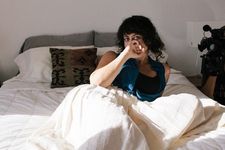 |
| Nina Millin as Beth: "The threat to me plays out in the moment of the revelation that Beth confides." Photo: Sonja Kinski |
AKT: Always with the Dardennes, there's a lightness although they go to areas that are so existential...
JRH: Brutal.
AKT: Brutal, yes, selling your baby. And yet, in The Kid With A Bike (2011), the scenes on the bike give us air to breathe. You have the scenes with the masks. Are they relief or escape?
JRH: The Day of the Dead, yeah. It's something that is in the culture at this moment. A lot of fashion photography is using it. A lot of amateur pin-up photography is using that kind of iconography and then, of course, there's the thing itself. The celebratory warding off the spirits and celebration of them. The dual nature of the holiday was very appropriate of what they're going through. At the end of the day, the events are not necessarily believable but it's very important that the performance is believable so that you go beyond.





















